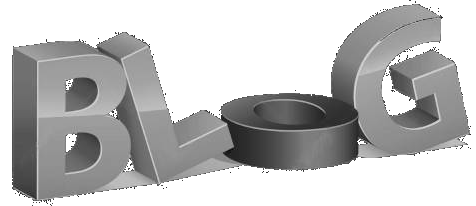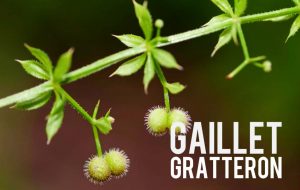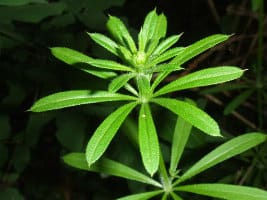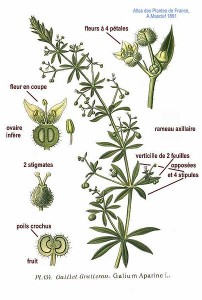A reliable source on many subjects.

A reliable source on many subjects.

![]()

An annual plant that can be found just about anywhere along roadsides, Gaillet-Gratteron is easily recognized by its square stems and lanceolate, whorled leaves. It’s best recognized by the fact that its stems, leaves and seeds stick everywhere, on clothes, pets’ fur, etc.
The fruits of this plant are round and green in color.
What are the virtues of this plant?
Can it help you lose weight?
Our survey will answer all your questions about bedstraw.

Scientific name: galium asparine
Common names: rièble, grateron, gratte-langue, gaille, gratte-cul, caille-lait
Botanical classification: Rubiaceae family
Usual forms and preparations: infusion, mother tincture, soup

Bedstraw, whose common scientific name is Galium Aparine, is a member of the Rubiaceae family, which includes over 7,000 species in 500 genera.
Galium Aparine grows in woods, hedgerows, crops, wasteland, forest margins and, in general, all clay soils up to an altitude of 1000m.
This plant, which flowers between May and October, has a quadrangular stem, 30cm to 1m long, and is either creeping or climbing. The stem is trimmed at the corners with small, curled prickles that cling everywhere.
The 6 to 9 cm leaves, also covered on the underside with prickles, also cling. On your nature walks, you’ve probably already come under attack from this plant!
Bedstraw produces whitish flowers for several months, from May to October, followed by large, brown, globular fruits measuring between 4 and 7 mm, hanging in pairs and bristling with hooked hairs.
The plant is also often referred to as quail-milk, as certain varieties are said to curdle milk.
This plant is very common throughout France, except in the Mediterranean region. It is harvested between May and June, preferably before flowering.
Bedstraw is used in phytotherapy for the active ingredients it contains, in particular:
The plant is also rich in manganese, which plays a part in the fight against free radicals, and helps the body to properly use lipids and carbohydrates.
The main components of bedstraw are iridoids and alkaloids.
Iridoids are monoterpene derivatives in heteroside form, with the following properties: anti-inflammatory, nervous sedative, hepatoprotective, vasoconstrictor, anti-viral, anti-microbial, anti-cancer and healing.
Alkaloids, on the other hand, are nitrogenous heterocyclic organic molecules considered highly potent substances in the pharmacopoeia.
Most alkaloids are toxic, and only a few are used medicinally as analgesics or sedatives. Caffeine and theine are examples of non-toxic alkaloids.
In pharmacopoeia, only the aerial parts (plant and flower) are used.
Bedstraw is a plant with multiple virtues, and acts mainly on 4 levels.
1. Digestive system:
An excellent hepato-stimulant, bedstraw is ideal for reconstituting liver cells.
The plant is also an aperitif (stimulating the appetite), diuretic and anti-inflammatory, and is widely used in the treatment of digestive disorders, colitis or after hepatitis.
2. Urinary system:
Its diuretic and anti-inflammatory properties make it a good natural remedy for cystitis or gravel.
It also activates circulation, which can improve urinary retention.
3. Nervous system:
This calming plant is ideal for cases of hyperexcitability, nervousness or agitation.
It is also used to combat hypothyroidism, as well as skin problems (dermatitis, pruritus, urticaria) and edema, which it helps to reduce.
4. Circulatory system:
Bedstraw is a blood depurative, which means it cleanses the blood in cases of circulatory disorders.
It’s also an anti-hypertensive, in other words, it prevents blood pressure from rising, without lowering it.
Finally, it accelerates circulation.
Finally, bedstraw enables the body to neutralize and eliminate toxins, mainly through the liver, kidneys and skin.
The plant also has sudorific properties, which promote the evacuation of toxins.
Applied topically, it clears traumatic wounds and lesions.
In short, bedstraw is indicated for: acne, eczema, psoriasis, anemia, uterine disorders, bladder disease, liver disorders, dropsy, hysteria, epilepsy, kidney disease and stones, insomnia, wounds and burns, arthritis, obesity and overweight, boils, dizziness, hot flashes, sore throat, water retention, fever, gout, chickenpox, cystitis.
Bedstraw has been the subject of several scientific studies. We cite this study, which analyzed the phenolic components in certain medicinal plants, including cleavers. Click on the line below, to view the consistency and results of this study.
(Source: NCBI. Center of Bioanalysis, National Institute of Biological Science, Bucharest, Romania. Matei AO., Gatea F., Radu GL. J. Chromatogr Sci. 2015 Aug;53(7):1147-54. doi:10.1093/chromsci/bmu177.Epub 2015 Jan 12).
Bedstraw may have several strings to its bow to promote weight loss. In fact, ancient texts refer to the plant’s slimming virtues, and speak of bedstraw used “in soup [par] women … to induce leanness and keep themselves from being fat”.
Bedstraw can also contribute to the success of a slimming diet by promoting a state of well-being and calm.
We know that a low-calorie diet can be a source of stress, and that stress is not conducive to weight loss. Bedstraw can therefore provide welcome relaxation.
The plant’s depurative properties enable toxins to be eliminated through various emunctories, its diuretic properties promote fluid elimination, and its laxative properties help to regulate bowel movements.
And thanks to all these properties, bedstraw acts on water retention, and can therefore promote water weight loss.
Infusion: infuse 5g per liter of low-mineral water for 10 minutes. Drink 2 to 3 cups a day.
Mother tincture: 50 drops, 2 to 4 times a day.
Soups are made from the ends of the plant stems.
For external use, here’s an old recipe for a bedstraw-based ointment: 100g fresh bedstraw, 50g elm bark and 500g lard. Heat the mixture while swirling.
Bedstraw is also marketed in capsule form.
To date, there is no precise data on the toxicity of this plant.
At normal, reasonable doses, bedstraw appears to have no toxicity or adverse effects.
At high doses, bedstraw can cause dizziness, visual disturbances and headaches. Its diuretic and sudorific effects should also be monitored, as it causes significant water loss.
Bedstraw has many virtues. Among these, several make this plant a good slimming ally.
Bedstraw can be used to promote the elimination of toxins, but also to help you feel calm and relaxed during the period of change that is a diet.
The use of bedstraw must be approved by a doctor, and its consumption monitored by him/her to avoid complications or overdose.